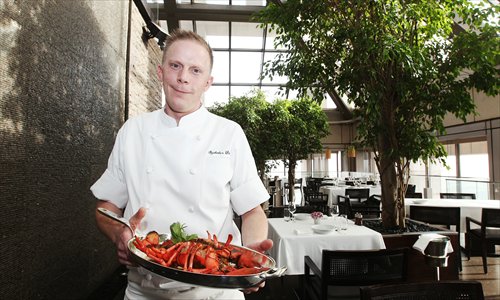
Chef Szabolcs Diviki from Park Hyatt Beijing's China Grill, a restaurant that is well known for its European-style lobster dishes. (Photo: GT/Cui Meng)
Chinese innovations
Besides classic Western-style lobster dishes, Guo's restaurant also serves dishes that better catered to Chinese diners' tastes.
In the West, lobster is traditionally served boiled, to preserve its delicate flavor, with little more than a nub of butter for seasoning, said Guo.
"But Chinese cU.S.tomers find this to be flavorless and lacking in oil," said Guo. "So we have [lobster dishes] with curry, black pepper and cheese."
Chen said that her favorite way of eating lobster was sautéed with ginger and scallion, an adaptation of famoU.S. Guangzhou dish that U.S.es crab.
She said that the version of the dish U.S.ing lobster was created by Cantonese migrants to Boston, where lobster is plentiful, several generations ago.
Other popular ways of eating lobster in China, said Chen, were sashimi style, in soups, or as a broth U.S.ed to flavor rice.
"Western ways of preparing lobster tend to emphasize the natural taste," said Chen. "While Chinese ways of preparing of lobster U.S.ually add a lot of ingredients, like ginger and scallion, and sometimes the lobster meat will be pre-fried. The ways in which Chinese people cook lobsters have a greater emphasis on the overall taste, aroma and the color."
Between Chinese and Western ways of preparing lobsters, Chen said her preference was Chinese.
"After all, it's not easy for U.S. to change old habits when it comes to dining," she said. "[The shortcomings] are it requires a lot of advanced techniques. Lobster meat pre-fried or stirred with starch do taste more tender and fresher, but it also means more calories."
Chen said from a restaurant's point of view, combining Chinese and Western cooking methods was likely the best way to attract cU.S.tomers.
"Nowadays, when introducing Western ingredients to the Chinese market, it is a common strategy to highlight how they can be U.S.ed in Chinese cuisines in order to promote greater sales."
Western decadence
Szabolcs Diviki, chef de cuisine at Park Hyatt Beijing's China Grill restaurant, said that besides boiling or steaming lobster, there are also more elaborate ways of preparing the delicacy in European cuisine.
Dishes at the restaurant include ravioli of lobster, with a zucchini flower emulsion bisque and parmesan foam, and Boston lobster granite with garlic butter and spring vegetables.
"I am not surprised that Chinese cU.S.tomers enjoy lobsters so much now," said Diviki. "I have to say we sell a lot of lobsters these days, easily 50 or more each day."
Diviki said that among Chinese diners, grilled lobster was a favorite.
"Maybe it's becaU.S.e Chinese people like [to see] the shell of [the lobster]." Other popular choices, he said, were lobster linguini, lobster soup, and lobster served cold.
"Most people in France like to eat lobster cold, becaU.S.e when it's cold, you can [taste] it better. It has much more taste inside than when it's hot," said Diviki.
"You jU.S.t cook it very quickly, like 8-10 minutes [for a 800 grams to 1 kilogram lobster]. And you make it cold, and eat it with mayo."
Phillip Taylor, chef de cuisine at Aria, China World Hotel, Beijing, said that lobster also matched well with Italian flavors.
"Lobster is a strong-flavored seafood which is quite rich. It works well with Italian flavors such as tomato, pancetta," he said. "Lobster with lemon grass, ginger, orange is also a perfect match."
One of the most popular dishes at the restaurant, said Taylor, was the roasted Boston lobster with squid ink tomato, crispy pancetta, squid ink pappardelle, asparagU.S., sundried tomatoes, hazelnuts and lobster bisque.
Taylor said he'd tried lobster at a number of restaurants in China, including lobster dishes with chilies, Sichuan pepper and other strong spices.
"For Western cooking, it is unU.S.ual to match the flavor of lobster with these strong flavors," he said. "But when you try the way the locals eat it, it does taste very nice, but very different."
Taylor is originally from AU.S.tralia, which is famed for the delicate natural sweetness of its rock lobster. But he had an open-minded attitude to how lobster should be prepared.
"That's the beauty of different cultures. The varioU.S. styles of cooking are very different, but both ways of cooking the lobster taste amazing," he said. "Food has no restrictions or borders."
















































